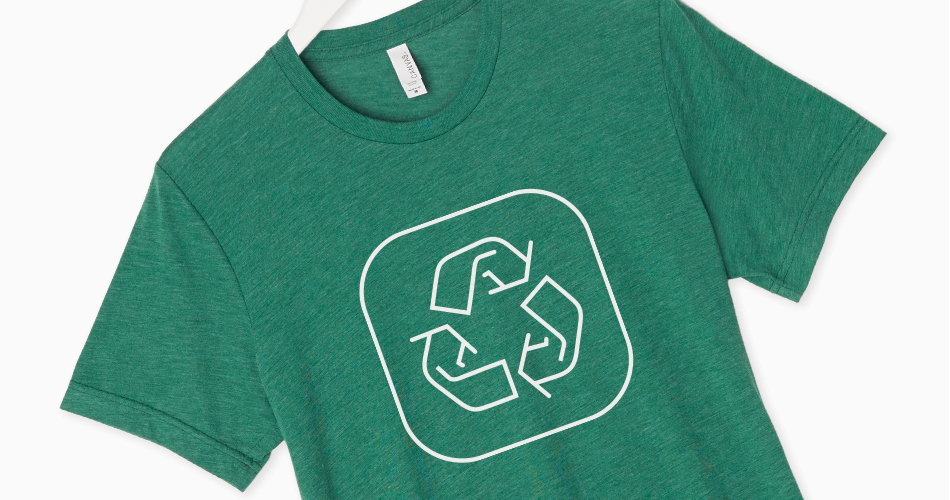At BELLA+CANVAS, we are all about sustainability. We only have one beautiful Earth on which to live our lives, so it is important to us that we model manufacturing processes accordingly. The same can work for you if you have a screen printing business. One fantastic way for you to differentiate yourself from your competitors (and in turn generate more business and make more money) is to create a sustainable workshop. Embracing a more sustainable practice not only wins you points with your customers, but also allows you to have a less damaging effect on the environment.
Thankfully, it’s no longer hugely difficult to rebrand yourself as a sustainable printing shop – there are new techniques and technology that make it easy to print custom ink without having a huge carbon footprint and damaging effect on the environment. With other printing shops following suit, too, it’s important that you begin to embrace this new technology and new practices. Not only that, more and more consumers are expecting companies to start offering green alternatives, and if you don’t adapt quickly enough, you could soon see your customers looking elsewhere for their custom fabric printing needs.
We love that Ryonet shares this mind-set. They’ve outlined everything you need to know about adapting your practice and transforming your shop. Here’s what you need to know!
Sustainable Printing Basics
Before getting into the nitty gritty, let’s take a look at the basics of transforming your shop. These are the primary areas for you to focus on.
- Improve waste recycling
- Install filtration systems
- Switch to water-based ink
- Use eco-friendly chemicals
These four simple measures can be taken with relative ease these days, and when combined with appropriate and effective marketing, you can set yourself up as a sustainable alternative to many other printing shops. You will also open up your products to brand new markets.
Using Greener Chemicals
The industry has shifted away from plastisol and solvent inks, and is now looking to soybean and citrus-based chemicals. These don’t rely on as many man-made chemicals that are harmful to the environment, and can achieve the same great results you expect from more traditional inks and chemicals.
Many manufacturers now sell eco-friendly chemicals, so speak to your usual supplier and ask what they have. It’s hard not to find them these days, and the switch can help improve business and, in turn, your profits.
You can also switch from using aerosols to using other eco-friendlier options which are becoming increasingly common, along with water-based adhesives and soy and citrus-based openers and degreasers.
Switch to Water-Based Ink
It might sound like a step backwards in terms of technology, but water-based ink can actually be just as effective and provide the same long-lasting print designs on all varieties of fabrics. There has long been a huge demand for plastisol inks thanks to how effective it is in creating bold and long-lasting designs, but at the same time, the ink contains toxic PVC and phthalates which has been shown to cause harm to humans. Not only that, but they’re terrible for the environment, and surprisingly pricey to purchase in the first place.
This makes water-based inks far more attractive. There really is no reason to stick with this old technology when water-based inks are now just as effective – there is, however, a learning curve.
When using water-based ink, you’ll need to adapt to the new temperatures required for curing, and how to blend colors to achieve the opacity you want. It’s not exactly the same as the plastisol process, mostly because the ink is not quite as opaque. However, this learning curve is nothing compared to the savings that can be made and the benefits of using greener equipment.
You will also benefit from using a humidifier in your workshop. The ink dries in your screens far quicker than traditional inks, and on cold days, it can dry even quicker. By using a humidifier, you can keep the air humid and stop the ink from drying too quickly. This also allows you to perform longer runs for multiple fabric prints!
It’s not all challenges, though – water-based ink is actually far easier to clean up. And, when printed on fabric, it’s hard to tell when the ink starts and the fabric begins, making your printed designs look far more high end than they might with traditional inks. So, you can charge more or incorporate your new premium products into your advertising.
Start Recycling
Even if you already recycle, there’s probably room for you to do more. You will likely know that screen printing results in lots of waste, and not just chemicals and inks. You’ll regularly find yourself throwing out rags, containers, film, cardboard and much more, and it’s important that you start recycling as much as possible if you don’t want to harm the environment.
Remember that just because you use water-based ink doesn’t necessarily mean you’re eco-friendly, which is why you should consider recycling your old film positives and maybe finding new uses for old water-based ink. You could even use old shirts, or misprinted shirts, as new rags for cleaning out empty containers that you can use to contain ink and other substances, as opposed to simply throwing them out.
Another interesting recycling idea centers round the disposal of old ink. Instead or pouring it down the drain or putting it in the trash, consider adding the ink to buckets of water and using them when mixing cements. You can then use the cement that you create to form benches and puts. Be creative, and enjoy the wild colors that the cement turns from the ink, too! Recycling doesn’t have to be an inconvenience, it can be fun and can result in interesting new products and items that can become a staple of your eco-friendly shop.
Or, if you’d rather put your ink down the drain, consider applying a screen mash at the bottom of your sink. This catches larger particles and allows only fluid and smaller particles to go down your drain, keeping it flowing and avoiding blockages.
Embrace a Green Identity
If you implement eco-friendly practices, that’s great! If you don’t advertise it, however, then you might not see much of an effect in terms of profit and brand identity. You need to ensure that your customers know about your practices, and the benefits of those practices – including a more premium appearance on printed images.
Incorporate your eco-friendly identity into your branding and marketing materials, and be sure to advertise the benefits to the customer, including bold colors and a seamless finish on t-shirts and more.
Remember that embracing green technology and recycling puts you ahead of the curve in this industry, so show it off!






